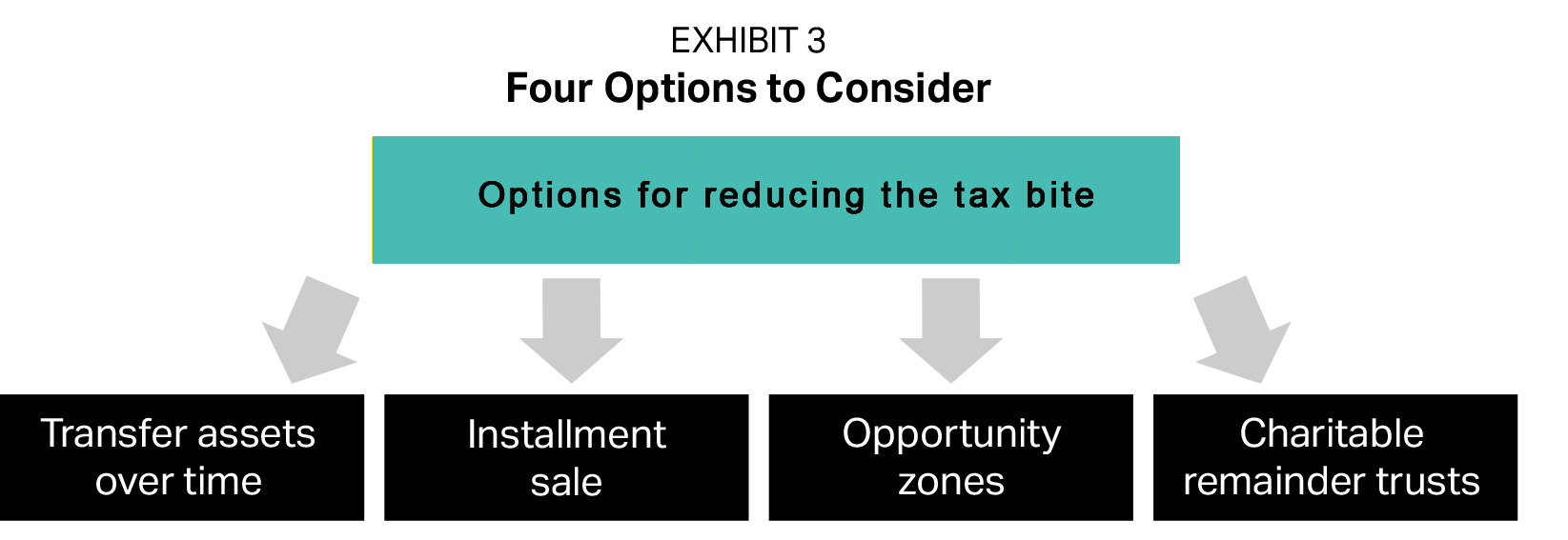Key Takeaways
- Installment sales can help spread out income over time, reducing your annual tax bill.
- Opportunity zone funds can potentially reduce or even eliminate a taxable capital gain.
- Charitable trusts help you mitigate taxes and have a philanthropic impact.

Chances are, you’ve invested an enormous amount of time and energy into your business. And if you’re like many entrepreneurs, you’ll one day be ready to sell the company and transition to the next chapter of your life.
If so, it makes sense to make your exit in a way that minimizes the tax bite you’ll encounter. Despite their many differences in goals and methods, business owners often agree that they want to pay as little as legally possible in taxes when they eventually sell their companies so they walk away with more money for themselves and their families.
The good news: There are numerous strategies that can potentially help mitigate taxes on the sale of your company. That said, laws, rules and regulations governing such strategies can shift with the political winds—so it pays to stay on top of tax-related developments when it comes to your business, as changes in tax laws can change whether a strategy makes sense for you.
Here’s a look at just some of the ways to reduce the tax bill when it’s time to hand over the reins to new owners (see Exhibit 3).

Transfer assets regularly over time
Have heirs who will one day take over the business? You can start gifting them that ownership now. Individuals can transfer up to $17,000 (while married couples can transfer up to $34,000) of stock in their company to each child, every year, without incurring taxes.* Giving the annual limits on such gifting, it’s unlikely that this basic approach will enable you to fully transfer ownership to one or more heirs. But it can the ball rolling on tax mitigation.
Installment sale
Selling your business may very well result in a profit that bumps you up into a higher income tax bracket than usual. That could mean a significantly larger tax bill than you expect or want. To avoid that outcome, you could consider agreeing to be paid over time by the buyer in regular installments instead of a one-time transaction. After getting an upfront payment, you’d receive the remaining sale proceeds (with interest) over annual installments. This approach would spread your tax bill over the period of the installment payments.
The length of the installment period can be negotiated between you and the seller. But obviously the longer the term, the greater the risk you could incur. Because you’re being paid over time rather than all at once at the sale, you’re relying heavily on the new owner. If he or she runs the company into the ground, you may end up with far less money than you expected.
The installment sale option is one that often is closely watched, due in part to frequent proposed legislative changes involving capital gains taxes. For example, one proposal that’s been debated would increase the top long-term capital gains tax rate from 20 percent to 39.6 percent for households with income of more than $1 million. Although that bogey might seem high—by one estimate, just 539,000 income tax returns were filed in 2019 with 2018 adjusted gross income of more than $1 million—it’s quite possible for business owners to hit it in the year they sell their companies.
* For 2023 (limits for 2024 were not yet available as of this writing).
In theory, an installment sale could be designed to keep your annual income below the $1 million threshold each year—helping to avoid the higher capital gains tax rate (if it comes to pass).
Warning: Only “capital gain income” is eligible for installment sales. Anything on which gains are treated as ordinary income cannot be used in installment sales. For these items—which include inventory, accounts receivable and property that’s been used for one year (or less)—you have to pay tax on any gains in the year you sell the company. Best bet: Review IRS guidelines and discuss with a tax expert if you are considering installment sales.
Opportunity zones
Another tax-advantaged option is to reinvest some or all of the sale proceeds into a qualified opportunity zone fund.
Opportunity zones are federally-categorized areas of the country with historically depressed levels of economic growth and historically high levels of poverty. Qualified opportunity zone funds are investment vehicles that invest in properties and businesses located in these opportunity zones, and are designed to help spark economic growth and jobs in these distressed communities (of which there are currently more than 8,000).
The IRS offers significant tax advantages to help motivate investors to allocate money to these funds. Example: If you sell your business (or stock or real estate) and reinvest some or all of the proceeds in a qualified opportunity zone fund within 180 days of generating a capital gain from the sale, you can defer paying taxes on that gain. In general (exceptions exist), the deferral lasts until December 31, 2026—at which time, the amount of the deferred gain that you invested in the fund becomes taxable.
Also, if you maintain your qualifying investment for more than ten years, its tax basis “steps up” to its fair market value as of the date you sell it. In short, your investment appreciates tax-free—and you won’t pay any capital gains tax on the appreciation when you sell it.
Keep in mind that the gain you reinvest in a qualified opportunity zone fund loses its deferred status if you sell before December 31, 2026. What’s more, the gain you reinvest in the fund must be a gain that is treated as a capital gain for tax purposes and one that you would otherwise have recognized if not for the opportunity zone investment.
Note: Opportunity zones are another area that, as of this writing, is receiving scrutiny from lawmakers in Washington D.C., who are examining whether the zones are working as intended.
Charitable remainder trusts
If you want to both reduce your tax bill when selling and have a philanthropic impact by. financially supporting a cause you care about, you may be well-served by using a charitable remainder trust (CRT).
This approach calls for irrevocably gifting some or all of your business to a CRT that’s created to benefit one or charitable organizations. The CRT can then sell the business interests—without incurring any capital gains taxes.
In addition, you would receive an income tax deduction in the year you transfer the business assets to the CRT. The size of that charitable deduction could potentially total tens of thousands of dollars, depending on the value of the business interests being transferred, your age, your adjusted gross income (the allowable deduction is limited to 30 percent of your adjusted gross income, with excess amounts carried forward for five years) and other factors.
On top of that, the CRT would then pay you an annual income stream for the rest of your life (or a certain number of years). That payment is determined using either a fixed dollar amount or a fixed percentage of the annually re-calculated net fair market value of trust assets, depending on the type of CRT structure used. Regardless, chances are that most of the annual income coming from a CRT that you funded with business interests would be taxed as a long-term capital gain—which currently is taxed at a lower rate than is ordinary income.
The upshot: A CRT has the potential to eliminate capital gains from the sale of your business, give you a charitable income tax deduction, and provide you with regular income that’s taxed at a relatively low rate. Keep in mind, however, that you can’t get back the business interests you transfer to a CRT—so be sure that charitable giving is a key goal before going this route.
Conclusion
The four strategies presented here represent just a portion of the tax-mitigation solutions that are available to entrepreneurs looking to sell their businesses. Additionally, as noted, several methods for reducing taxes are being examined and assessed by lawmakers in the White House and on Capitol Hill—but it remains to be seen, as of this writing, what (if anything) will change.
Your best bet: Reach out to your trusted advisors to both review the full range of tax-mitigation resources that may be available to you and to get updated on the latest developments impacting a particular solution.


0 Comments